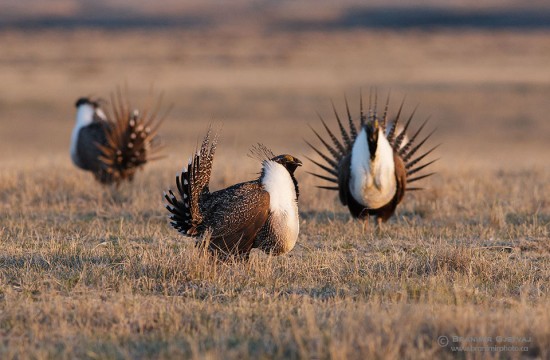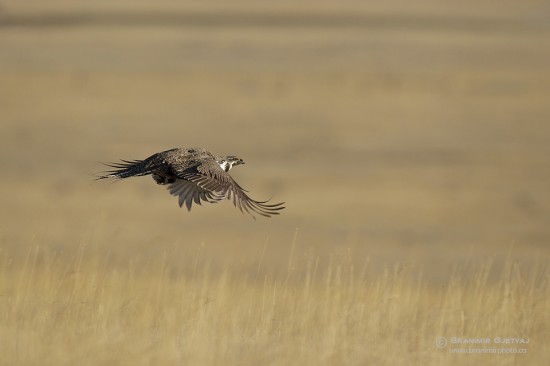After many months of inaction and a few lost court cases, (see also news item about a court order requiring the government to designate critical habitat under the Species at Risk Act), the federal Environment Minister Leona Aglukkaq announced today that an emergency order to protect an endangered species Greater Sage Grouse will be issued in the coming months. The order will impose restrictions on development and industrial activities to protect the Sage Grouse and its habitat on provincial and federal Crown lands in Alberta and Saskatchewan. The proposed restrictions will not affect activities on private land, nor will they restrict cattle grazing on federal and provincial Crown lands. The emphasis is on controlling the industrial activity that has had the largest impact on the species’ survival. Information posted on the Environment Canada’s backgrounder info sheet explains the intent of the announced measures:
“Some constraints would applied to land use on approximately 1200 km2 of crown land in Saskatchewan and Alberta. The intent is to address seasonal noise, destruction of habitat, disturbance of breeding sites, and the creation of new structures without imposing restrictions on activities on private land, nor on grazing on provincial or federal crown lands. Our goal is to achieve the best protection for the Sage-Grouse while minimizing impacts on agricultural producers.”
An emergency order – a rare measure that has not been issues since the Canada’s Species at Risk Act was proclaimed in 2002 – can be issued when a species faces “imminent threats to its survival” and existing protection measures are deemed inadequate. Concerns have been raised that the endangered Sage Grouse could disappear from Canada after a dramatic drop in its population numbers over the last few years. Saskatchewan’s Ministry of Environment surveys conducted in 2012 show that there were only 55 to 80 individual birds left in the province, which is a 49% decline from the year before, or an 81% decline from 1994 when lek (breeding ground) counts first started. Situation in Alberta is even worse, with only a few dozen birds remaining in the province. The Greater Sage Grouse was present in British Columbia but is now considered extirpated there. According to the Environment Canada, fewer than 140 birds are left in the two western provinces, and the species’ population size has fallen 98% since 1988. The causes of the population decline include: loss or degradation of habitat, predation, and disease. Because there are so few individual birds left in Canada, the species here is vulnerable to extreme weather events.
Announcement of the emergency order to protect the Greater Sage Grouse is a step in right direction. Although, it is important to note that this is just an announcement that the order will be issued sometime in the future.
In a statement issued to the Canadian press, Melissa Gorrie, lawyer for the group Ecojustice, said that “(We) have yet to see when – or even if – the emergency order will be implemented, and whether it will provide real, meaningful protection for these prairie birds and their critical habitat”. It is possible that the federal government will continue delaying the implementation of emergency measures or talk about “gradual implementation” of recovery measures.
Delaying any activity and decision-making on the Species at Risk in Canada is a standard mode of action for the current federal Environment Ministers. In a recent article published by Globe and Mail, three scientists from the group called Scientists for Species reveal how recommendations for listing of Species at Risk in Canada can be delayed for over 1519 days in transit from the minister’s desk to the rest of the cabinet and the governor-in-council. That is 50 months or 4.2 years. By the time the emergency measures are issued and implement, there may be no birds left in Alberta.
This disregard for the timelines set by the Species at Risk Act was identified as early as 2008, when Parliament’s Standing Joint Committee on Scrutiny of Regulations cautioned the government that a delay in transferring the recommendations to list a species as being at risk (under SARA) was not the intent of the law.
Read the related news items about the Greater Sage Grouse announcement
- CBC News: Endangered sage grouse to be protected by emergency order
- The Globe and Mail: Ottawa moves to protect endangered sage grouse
- Environment Canada press release:
OTTAWA, Ont. – September 17, 2013 – The Honourable Leona Aglukkaq, Minister of the Environment, Minister of the Canadian Northern Economic Development Agency and Minister for the Arctic Council, announced today the Government’s intention to introduce an Emergency Protection Order for the Greater Sage-Grouse in the coming months.
The intent of an Emergency Order is to impose obligatory restrictions designed to protect the Sage-Grouse and its habitat on provincial and federal crown lands in Alberta and Saskatchewan with no restrictions on activities on private land, nor on grazing on provincial or federal crown lands. Our goal is to achieve the best protection for the Sage-Grouse while minimizing impacts on landowners and agricultural producers.
“Through a combination of stewardship measures we are addressing the imminent threats to the Greater Sage-Grouse,” said Minister Aglukkaq. “We will be working with provinces and stakeholders over the coming months to implement these measures.”
An Emergency Order would build on efforts the Government of Canada is already taking to protect the Greater Sage-Grouse. We are partnering with the Government of Saskatchewan, Government of Alberta, the Calgary Zoo and other stakeholders such as the Alberta Conservation Association on several innovative new projects to support the long term recovery of the Sage-Grouse populations. We have already committed to providing over $1 million in funding over the next three years for projects to protect Sage-Grouse and other species at risk in Alberta and Saskatchewan. Additional funding will be available under the Habitat Stewardship Program to support landowners and other stakeholders in protecting Sage-Grouse.
An Emergency Order under the Species at Risk Act (SARA) can be used when a species faces imminent threats to its survival, and current protection measures are deemed inadequate. An Emergency Order for Greater Sage-Grouse would protect the habitat necessary for the survival of the species. This would be the first time since the Act’s inception that this mechanism is being invoked.
The Greater Sage-Grouse is an endangered bird that depends on the unique prairie ecosystem of southeastern Alberta and southwest Saskatchewan. The Sage-Grouse population in Canada has declined by nearly 98% since 1988, with less than 150 birds now remaining in Alberta and Saskatchewan.




